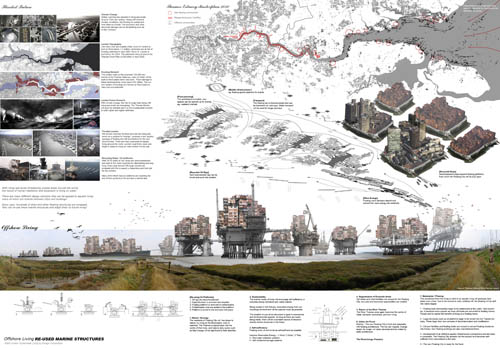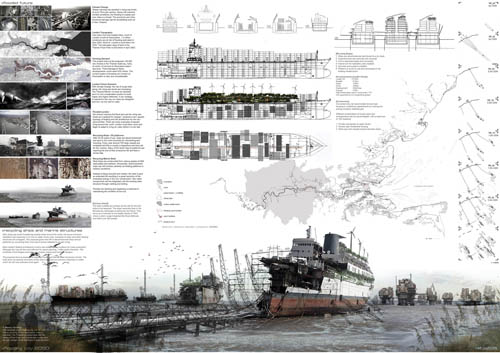 [Image: From "Floating City 2030: Thames Estuary Aquatic Urbanism" by Anthony Lau].
[Image: From "Floating City 2030: Thames Estuary Aquatic Urbanism" by Anthony Lau].
Continuing with a look at some noteworthy student projects—which kicked off this week with thesis work by Taylor Medlin—we now look at a proposal by Anthony Lau, submitted back in 2008 at the Bartlett School of Architecture in London. For that project, Lau designed a "floating city" for the Thames Estuary, ca. 2030 A.D. This "Thames Estuary Aquatic Urbanism," as Lau refers to it, "gives new life to decommissioned ships and oil platforms by converting them into hybrid homes adapted for aquatic living."
While the idea of offshore architecture has been relatively depleted of its novelty over the last few years, the presentation and imaginative extent of Lau's idea is of sufficiently high quality to deserve wider exposure and a longer look. 
 [Images: From "Floating City 2030" by Anthony Lau].
[Images: From "Floating City 2030" by Anthony Lau].
"Most modern floating architecture involves new-build modular systems for mass production," Lau writes. "Although this may be the most efficient for space planning, it often lacks character." His alternative:
- The multitude of hull shapes and sizes can inspire unique and inventive design. The proposal aims to express the beautiful forms and internal steel structures of hulls. The hulls serve as nautical reminders of the ship’s past and our previous closeness to water, which we will now embrace once again.
You can see larger versions of these images (some of which have been cropped down and recombined to fit the vertical nature of this post, which means that you will see different groupings at this link) here.





 [Images: Models from "Floating City 2030" by Anthony Lau].
[Images: Models from "Floating City 2030" by Anthony Lau].As Lau writes: "By utilising the flooded landscape, a floating city of offshore communities, mobile infrastructure and aquatic transport will allow the city to reconfigure through fluid urban planning. Wave, tidal and wind energy will be ideal for this offshore city and the inhabitants will live alongside the natural cycles of nature and the rhythms of the river and tides."
He adds that "this strategy for creating a self sufficient floating city by reusing ships and marine structures can also be applied to island nations such as the Maldives. Over 80% of its 1,200 islands are around 1 m above sea level. With sea levels rising around 0.9 cm a year, the Maldives could become uninhabitable within 100 years. Its 360,000 citizens would be forced to adapt and they could become the first floating nation."
 [Image: From "Floating City 2030" by Anthony Lau].
[Image: From "Floating City 2030" by Anthony Lau].If Lau's work piques your interest, you might also want to take a look at a report released last year by the Institution of Civil Engineers and the Building Futures group, called "Facing Up To Rising Sea Levels: Retreat? Defend? Attack?"
- Looking to a 100 year horizon of climate change predictions, we will address how the urban, built environment needs to react now. Conservative estimates predict sea-levels to continue ro rise as the oceans warm and the ice caps melt. Coupled with isostatic rebound (the South sinking relative to the North) the effects grow ever more dramatic for large centers of population on the coast. Predicted weather patterns show increased rainfall intesity, leading to sever problems of surface water flooding in built up areas.
Interestingly, meanwhile, one of Lau's initiatives since graduating from the Bartlett is to form a company focusing on urban bicycle infrastructure, specifically the Cyclehoop, "an award-winning design that converts existing street furniture into secure bicycle parking." It's also quite colorful. But perhaps a Boathoop is in the works for residents of his future Floating City...
For substantially larger project images, click here.
(Follow Lau's Cyclehoop project on Twitter: @cyclehoop).